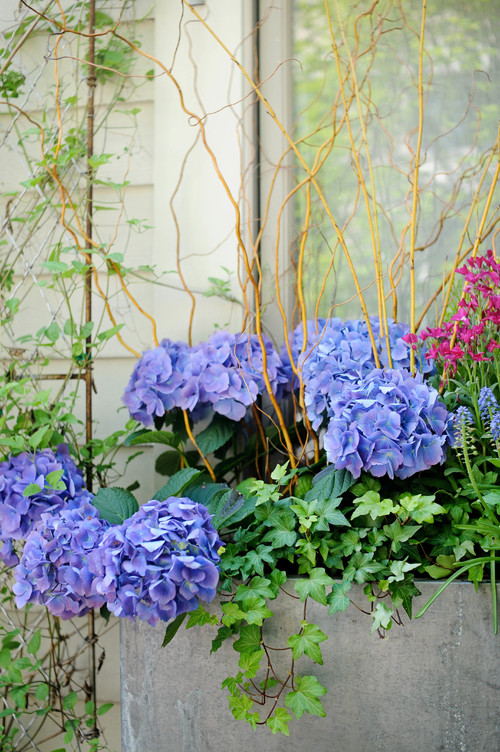Trailing Hydrangeas: The Perfect Plants For Vertical Gardens
Trailing Hydrangeas: The Perfect Plants for Vertical Gardens
If you're looking for a beautiful and easy-to-grow plant for your vertical garden, look no further than the trailing hydrangea. These versatile vines can add a touch of elegance to any space, and they're relatively low-maintenance to boot.
In this blog post, we'll take a closer look at trailing hydrangeas, including their different varieties, how to care for them, and how to use them in your garden.
What are trailing hydrangeas?
Trailing hydrangeas are a type of climbing vine that is native to Asia. They are known for their delicate white flowers, which bloom in the summer. Trailing hydrangeas can grow up to 30 feet long, making them ideal for covering walls, fences, and trellises.
Different varieties of trailing hydrangeas
There are several different varieties of trailing hydrangeas, each with its own unique characteristics. Some of the most popular varieties include:
- Hydrangea anomala petiolaris: This is the most common variety of trailing hydrangea. It has white flowers and heart-shaped leaves.
- Hydrangea seemannii: This variety has evergreen leaves and white flowers that bloom in the spring.
- Hydrangea serratifolia: This variety has white flowers and serrated leaves.
How to care for trailing hydrangeas
Trailing hydrangeas are relatively easy to care for. They prefer moist, well-drained soil and partial shade. They should be watered regularly, especially during hot, dry weather. Trailing hydrangeas can be pruned in the spring to shape them or to remove any dead or damaged branches.
How to use trailing hydrangeas in your garden
Trailing hydrangeas are a versatile plant that can be used in a variety of ways in your garden. They can be used to cover walls, fences, and trellises. They can also be used to create a cascading effect over rocks or other structures. Trailing hydrangeas can also be used as groundcover in shady areas.
Here are some ideas for using trailing hydrangeas in your garden:
- Cover a bare wall or fence with a trailing hydrangea to add some privacy and beauty to your outdoor space.
- Create a vertical garden by planting trailing hydrangeas on a trellis or arbor.
- Use trailing hydrangeas to soften the edges of a walkway or patio.
- Plant trailing hydrangeas under trees to create a shady spot for sitting or relaxing.
- Use trailing hydrangeas as groundcover in a shady part of your garden.
No matter how you choose to use them, trailing hydrangeas are sure to add a touch of beauty and elegance to your garden.
Trailing hydrangeas are a beautiful and versatile plant that can add a touch of elegance to any garden. These vines can grow up to 30 feet long, making them perfect for covering walls, fences, or arbors. They also produce large, white flowers in the summer that are sure to turn heads.
If you're interested in learning more about trailing hydrangeas, I recommend visiting . This website has a wealth of information about these plants, including their care requirements, different varieties, and how to plant them. You can also find photos and videos of trailing hydrangeas in bloom.
I hope you'll visit to learn more about these amazing plants.
FAQ of trailing hydrangea
- What is a trailing hydrangea?
A trailing hydrangea is a type of hydrangea that has long, vining stems that can grow up to 10 feet long. It is known for its beautiful, cascading flowers that can bloom in a variety of colors, including white, pink, blue, and purple. Trailing hydrangeas are relatively easy to care for and can be grown in a variety of climates.
- Where can I plant a trailing hydrangea?
Trailing hydrangeas prefer full sun to partial shade and well-drained soil. They can be planted in a variety of locations, including gardens, borders, and hanging baskets. If you are planting a trailing hydrangea in a garden, make sure to give it enough space to spread out.
- How do I water a trailing hydrangea?
Trailing hydrangeas need regular watering, especially during the first year after planting. Water your hydrangea deeply once a week, or more often if the weather is hot and dry. Be sure to water the soil around the plant, not just the leaves.
- How do I fertilize a trailing hydrangea?
Trailing hydrangeas should be fertilized once a year in the spring. Use a balanced fertilizer, such as 10-10-10, and apply it according to the package directions. You can also use a slow-release fertilizer, which will release nutrients over a longer period of time.
- How do I prune a trailing hydrangea?
Trailing hydrangeas do not need to be pruned heavily. However, you can trim back the stems in the spring to encourage new growth. You can also remove any dead or damaged branches.
Image of trailing hydrangea
5 different images of "trailing hydrangea" from Pinterest:





Post a Comment for "Trailing Hydrangeas: The Perfect Plants For Vertical Gardens"